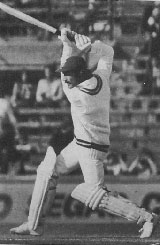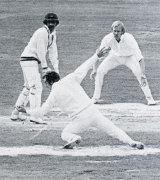Wasim Raja - A breathtaking strokeplayer
Gideon Haigh profiles interesting characters who might not remembered as great players, but in their own individual ways, added value to the game
Gideon Haigh
20-Dec-2005
|
|

|
Raja: the very name has a hint of the toff. And when Wasim Raja represented Pakistan in the 1970s and 1980s, he always gave you the feeling that cricket was there for his pleasure, not he for its, with all the thrills he could pack into it. Kevin Pietersen at The Oval equalled his record for sixes in a Test series: 14. But Raja set his mark in the Caribbean at the zenith of Roberts, Garner, Croft, unprotected by headgear, and apparently unencumbered by care: a brand from the burning, if ever there was.
Footage of cricket from those days now seems from slightly longer ago than it actually is. Players not encrusted with helmets, not upholstered with protective equipment, with stances and techniques not pressed from a coach's template. As a game, it almost more closely resembles club cricket than the pasteurised, homogenised, globalised game played today.
Raja had methods so homespun that they might almost have been designed to engage the eye. He bent low from the waist in his left-hander's stance, peering eagerly down the pitch, pounding his looping preliminary pick ups into the earth like a woodsman bisecting a log.
Raja was all eye and wrist, hands at the top of the handle, feet tending to follow his strokes rather than lead them, with a bravura backlift that no coach would condone now and selectors distrusted then, excluding him from 28 Tests amid the 57 he played. You can't entirely blame them either. While Javed Miandad called Raja a breathtaking strokeplayer, that was doubtless partly from sighs of exasperation.
Yet it looked great, and so did Raja, assuredly one of the handsomest men to grace a cricket field, with a natural ease of movement, a willowy physique, and helmet of black hair that he later complemented with a suave beard. When Raja failed, in fact, it was like a cavalryman's fall: not war, to reverse the French marshal's formulation, but magnificent. A glimpse of him can be found amid footage of Botham's Test-best 8 for 34 at Lord's in 1978: while his comrades poke and prod at the swinging ball, Raja hurls himself at an inswinger, eyes ablaze with defiance, then throws his head back as the bowler accepts a return catch from his leading edge.
I particularly recall Raja taking guard at Perth in November 1981 with Pakistan 4 for 17. Lillee greeted him with a bouncer: it was hooked thrillingly, fecklessly, for four. Lillee followed with another bouncer, faster, fiercer, straight from his salad days, straight at the outside of Raja's right eyebrow.
|
|

|
It was a trap, but Raja couldn't help himself. The voluminous backlift uncoiled, the body pivoted, the centrifugal force almost swung him off his feet: the result was the latest of top-edged hooks to the finest of deep fine legs, having travelled at little more than head height all the way. It was a ridiculous, reprehensible, culpable waste of a wicket in a total of 62 that barely lasted 20 overs - yet somehow ennobling.
For when Raja came off, it was in essentially the same proud and prodigal way. He did everything with style. He bowled speculative leg breaks with a whippy action, his arms blurring like those of a juggler, once bowling Pakistan to an eight-run one-day victory at Adelaide by winkling out four West Indians in half an hour. He prowled the covers with a sinuous walk, and chased the ball with an improbably elastic stride that ate up distance. It was a Pakistan team full of grandees in those days - Imran, Majid, Asif Iqbal, Zaheer Abbas - but Raja lost in comparison with none of them.
And what of that Caribbean summer almost 30 years ago when he topped batting and bowling averages: 517 at 57.4 and seven wickets at 18.7? A few players successfully thwarted the West Indian teams of Clive Lloyd and Viv Richards, but perhaps none so extravagantly as Raja, displaying a kind of fighter ace's disdain for danger, feet off the ground as he slashed over point, skedaddling down the pitch to take advantage of any slow bowling he saw, enjoying the slight freedom of movement available to the left-hander, and perhaps also a scenario in which his mercurial ways were best. Majid said that Raja seemed during those five Tests to hit a six when he liked; and liking was the essence of the effort.
Raja's average of 57.43 from 11 Tests against West Indies in the Lloyd-Richards years, in fact, surpasses even those of Sunil Gavaskar (53), Graham Gooch (45), Allan Border (39), Mohinder Amarnath (38) and Allan Lamb (34): an astounding statistic, not least from a batsman who never gave the appearance of contemplating them, let alone coveting them. A toff, perhaps, but one to lift one's lid to.
Gideon Haigh is a cricket historian and writer